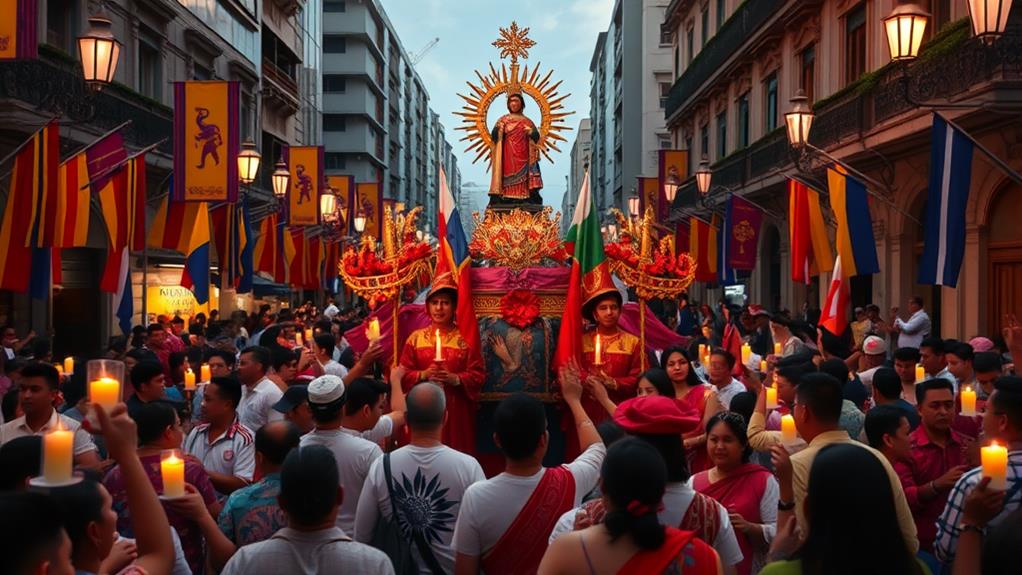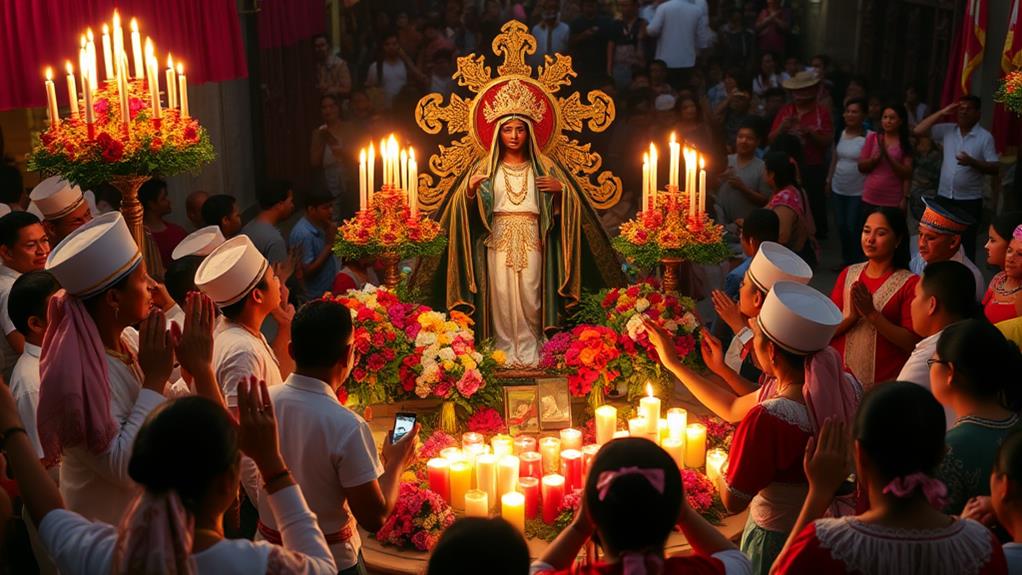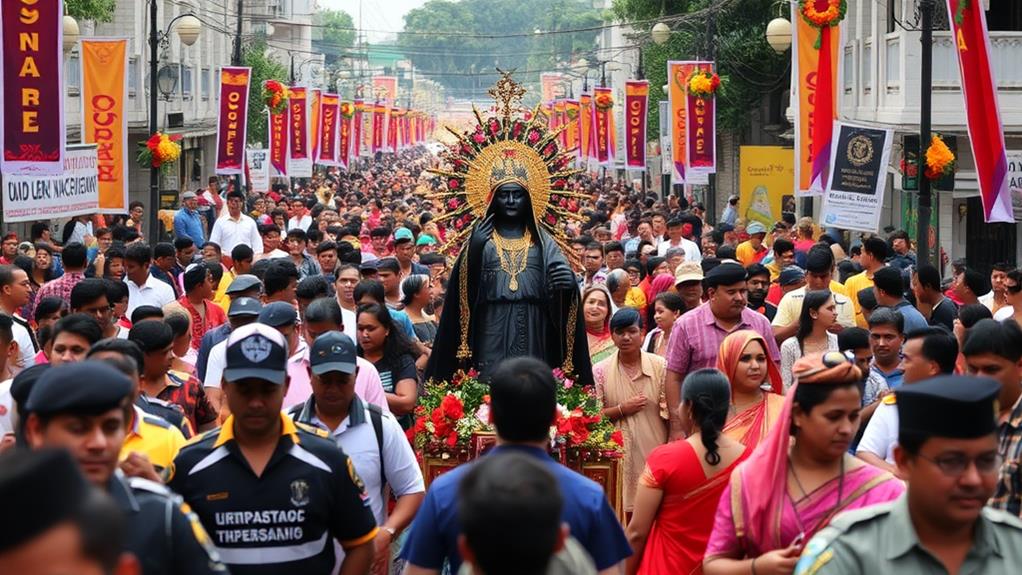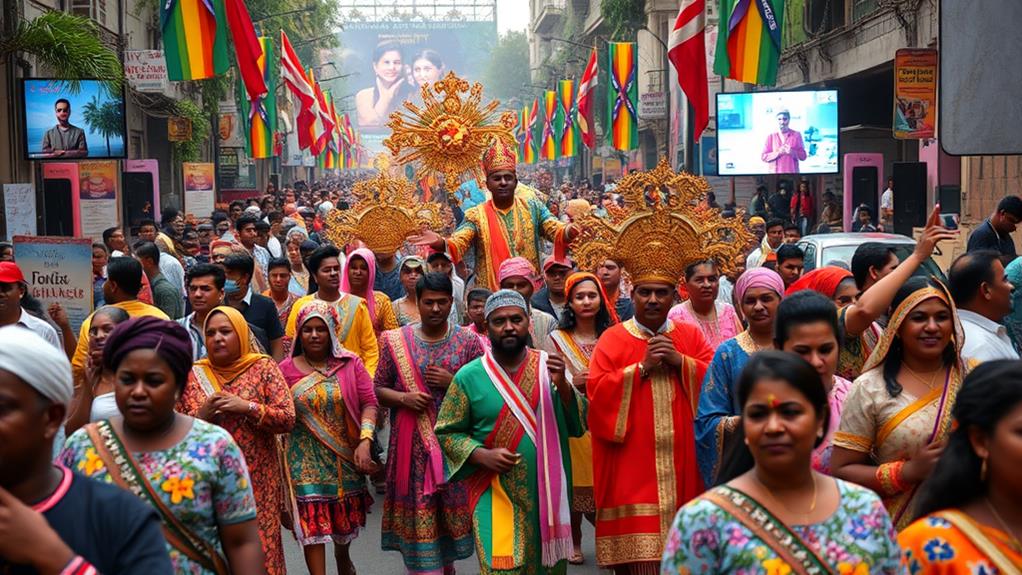The Black Nazarene is a revered statue in the Philippines that embodies hope and resilience. Brought to the country in the 17th century, it attracts around 10 million devotees annually, particularly during the vibrant Translacion procession.
This event showcases a unique blend of indigenous traditions and Spanish Catholicism.
During the procession, devotees engage in heartfelt rituals, such as kissing the statue for miraculous healing. This practice demonstrates the depth of their faith and the significance of the Black Nazarene in their lives.
The event ultimately transforms into a unifying experience, highlighting the strong community bonds among the devotees.
By exploring the history of the Black Nazarene, you will uncover the layers of devotion and cultural significance surrounding this revered statue. This understanding will provide insight into the importance of the Black Nazarene in Philippine culture and its enduring impact on the lives of millions of devotees.
Historical and Cultural Context

The Black Nazarene: A Powerful Icon in Filipino Spirituality
The Black Nazarene is a deeply revered icon in the Philippines, with historical roots dating back to the early 17th century when it was brought from Mexico.
Carved from mesquite wood, this statue symbolizes hope and resilience for millions of Filipinos, particularly the marginalized.
The annual Feast of the Black Nazarene, held on January 9th, attracts around 10 million devotees to Quiapo, Manila, showcasing a collective identity rooted in shared rituals.
The grand Translacion procession exemplifies the blending of indigenous beliefs and Spanish Catholicism, reflecting the adaptability of Filipino spirituality.
The Black Nazarene serves not only as an object of veneration but also as a unifying force, reinforcing cultural ties and fostering a deep sense of identity among Filipinos.
This powerful icon enriches the spiritual landscape of the Philippines, uniting devotees across socio-economic challenges and individual struggles.
Significance of the Black Nazarene
The Black Nazarene is a cornerstone of Filipino spirituality, embodying hope and faith for millions.
Beyond mere religious observance, the Black Nazarene holds profound significance as a symbol of faith, unity, and resilience. This statue of Jesus Christ carrying the cross is believed to possess miraculous healing powers, inspiring perseverance amid challenges.
Each year, millions participate in the Feast of the Black Nazarene on January 9, witnessing the vibrant Traslacion procession.
The massive turnout, sometimes reaching up to 10 million participants, reflects the statue's role as a unifying force, transcending social and economic divides. The event's massive participation demonstrates the statue's ability to bring people together.
The Black Nazarene's origins date back to the mid-1600s, symbolizing the resilience of the Filipino people.
The statue's rich history resonates deeply with the struggles of the Filipino people, inspiring hope and faith in the face of adversity. Its blend of indigenous beliefs and Spanish Catholicism makes it a powerful symbol of cultural identity and community.
The Black Nazarene serves as a tangible symbol of faith, fostering belonging within the community.
It encapsulates the shared experience of devotion, connecting individuals to a larger narrative. The statue's significance extends beyond a simple religious icon, becoming a powerful emblem of hope, unity, and resilience.
Devotional Practices and Beliefs

Devotional Practices of the Black Nazarene
The Black Nazarene devotional practices are rooted in a deep reverence for the statue of Jesus Christ, reflecting the devotees' beliefs and experiences. These rituals demonstrate their spiritual connection and foster a sense of community.
Pahalik: Transferring Miraculous Healing Powers
Kissing the statue of the Black Nazarene is believed to transfer miraculous healing powers. This practice is a testament to the devotees' faith in the statue's ability to heal and protect them.
Pasindi: Illuminating the Path of Faith
Lighting candles symbolizes prayers and hopes, illuminating the path of faith for devotees. This practice represents their desire for guidance and protection.
Pabihis: Showcasing Devotion and Personal Investment
Changing the garments of the Black Nazarene showcases devotees' devotion and personal investment in their faith. This practice highlights their commitment to honoring the statue and its significance in their lives.
Pagyayapak: Emulating Christ's Suffering
Walking barefoot during the Translacion Procession emulates Christ's suffering, often resulting in injuries that devotees embrace as part of their penitential practice. This practice demonstrates their willingness to sacrifice and atone for their sins.
The Power of Touch and Communal Spirit
The act of touching or wiping the statue is particularly powerful, with numerous testimonies of miraculous cures. This practice highlights the intimate connection between the faithful and the divine, fostering a sense of belonging and purpose within the vibrant community of Black Nazarene devotees.
The Vigil and Translacion Procession
The Vigil and Translacion Procession of the Black Nazarene is a vibrant display of faith and community. On January 8, around one million participants gather at Rizal Park for the vigil, where they engage in singing, dancing, and uplifting talks led by clergy members.
The next day, January 9, begins with a morning Mass at Rizal Park, followed by the Translacion procession, which covers a 6.5 km route to Quiapo Church. During the procession, many devotees walk barefoot as an act of penance, emulating Christ's suffering. The atmosphere is lively, with chants of "Viva, viva," although the large crowd often causes significant delays, sometimes extending late into the night.
Key Details:
| Event | Details |
|---|---|
| Vigil Date | January 8 |
| Participants | Approximately 1 million |
| Procession Distance | 6.5 km from Rizal Park to Quiapo |
| Common Act | Walking barefoot as penance |
The procession features diverse statues brought by various groups, showcasing the deep-rooted devotion to the Black Nazarene and enriching the communal experience.
Safety Concerns and Attendance

Safety Concerns at the Feast of the Black Nazarene
The Feast of the Black Nazarene attracts an astonishing 5 to 15 million participants, making it a significant safety concern.
Injuries and fatalities can occur due to the intense and overwhelming atmosphere. For instance, heart attacks and injuries during the procession have been reported, highlighting the need for vigilance.
Medical Assistance is Available
Authorities deploy medical teams along the procession route to assist those in distress. These teams are ready to provide immediate medical attention to those who need it.
Infrastructure and Logistics are Crucial
The massive crowds necessitate improved infrastructure and logistical measures to manage the event effectively. This includes implementing crowd control measures to prevent overcrowding and ensuring that emergency services can quickly respond to any incidents.
Emotional Fervor Requires Crowd Control
The emotional fervor of the devotees sometimes leads to dangerous situations, making crowd control essential.
Authorities must be prepared to intervene to prevent dangerous situations from escalating.
Remaining Vigilant is Key
As you navigate through the massive crowds, it's crucial to remain aware of safety measures.
Stay informed about the event's safety protocols and follow instructions from authorities to ensure a safe and enjoyable experience for everyone involved.
Socioeconomic Impact on Communities
The Black Nazarene Procession: A Symbol of Hope for Local Communities
The Black Nazarene procession profoundly shapes local communities, particularly among the economically disadvantaged. With an estimated 10 million participants, the procession becomes a powerful symbol of hope for poor people seeking solace in their faith. This shared experience fosters a strong sense of community, allowing individuals to cope with their socioeconomic struggles.
The procession provides a sense of agency and hope for participants. Many believe that participating in the procession brings miraculous healings, reinforcing their faith and providing a sense of agency in difficult times.
This deep connection not only helps them face personal hardships but also strengthens their collective resolve against adversity.
The event has a positive impact on the local economy. The procession stimulates the local economy, as vendors sell food and religious items, creating temporary jobs and boosting livelihoods for many families in Quiapo.
This economic boost helps many families make ends meet.
Outreach programs linked to the Black Nazarene devotion further enhance this impact. Organizations like the LBN Foundation address pressing social issues, promote charity, and cultivate a sense of collective responsibility, enriching the community as they navigate life's challenges together.
These programs provide essential support to those in need, fostering a sense of community and social responsibility.
Future of the Celebration

Building on the strong sense of community fostered by the Black Nazarene procession, the future of this vibrant celebration looks promising yet requires thoughtful adaptation.
Safety First: Ensuring the well-being of millions attending is a top priority. Authorities are implementing measures to prevent overcrowding, improve emergency response systems, and increase security presence.
Cultural Significance: The celebration will continue to reflect the importance of faith and answered prayers in Filipino culture. For instance, devotees will still carry replicas of the Black Nazarene as a symbol of their devotion, and the procession will remain a testament to the power of collective prayer.
Social Dialogue: The celebration serves as a platform for addressing pressing social issues. It reminds us of our collective responsibility to tackle concerns such as poverty, inequality, and environmental degradation.
In the future, the event will continue to amplify the voices of marginalized communities.
Inclusive Unity: Future celebrations will strive to unite devotees from diverse backgrounds. The church will work to create an inclusive environment, encouraging participation from people of all ages, genders, and socio-economic backgrounds.
This unity will be reinforced throughout the year, fostering a sense of community beyond the celebration itself.
Questions and Answers
What Is the Tradition of the Black Nazarene?
The Black Nazarene tradition is a unique blend of faith and cultural heritage. This annual event draws millions of devotees who gather to showcase their deep devotion. The procession is a significant part of the tradition, where participants engage in various devotional practices.
Pahalik and Pagyayapak are two essential devotional practices. Pahalik, which means "to touch," allows devotees to touch the Black Nazarene's image as a symbol of their devotion. Pagyayapak, or "to kiss," involves kissing the image as a sign of reverence. These practices connect devotees with a rich spiritual legacy that has been passed down through centuries.
The Black Nazarene tradition not only highlights individual faith but also unites the community. It emphasizes the resilience and adaptability of Filipino spirituality, which has endured for centuries despite external influences.
What Is the Theology of the Black Nazarene?
The theology of the Black Nazarene combines faith practices with cultural significance, shaped by historical context.
This unique blend of beliefs reflects the struggles and hopes of marginalized communities, making the Black Nazarene a powerful symbol of suffering and hope.
Devotion to the Black Nazarene fosters resilience among these communities, as seen in rituals like Pahalik and Pagyayapak. These rituals integrate indigenous beliefs with Catholicism, creating a distinct spirituality that resonates with personal struggles.
This spirituality emphasizes the transformative power of faith in everyday life, inviting divine intervention to address life's challenges.
What Are the Negative Effects of Black Nazarene?
Crowd Control Issues: The Black Nazarene procession attracts millions of attendees, making it challenging to maintain order and ensure public safety.
This massive gathering increases the risk of injuries from trampling or exhaustion, as well as other health risks associated with large crowds.
Economic Strains: While the event boosts local economies, the overwhelming number of participants can strain resources, leading to negative economic impacts for the community.
For instance, local businesses may struggle to accommodate the influx of visitors, resulting in losses and damages.
Balancing Devotion with Safety: It's crucial to strike a balance between devotion and safety to preserve the spirit of this fervent celebration.
This can be achieved by implementing effective crowd control measures and providing adequate resources to support the large number of attendees.
What Does the Nazareno Symbolize?
The Nazareno represents profound religious devotion and cultural identity for many Filipinos. This is evident in the way devotees interact with the statue, seeking comfort and solace during difficult times.
For instance, during processions, devotees touch or wipe the statue with cloths, believing that the Nazareno's power can heal their physical and emotional afflictions.
This shared experience fosters a sense of community and belonging among devotees, bridging cultural and socio-economic divides.
The Nazareno is a powerful symbol of resilience and faith, reminding Filipinos that their spirituality and traditions can help them overcome life's challenges.